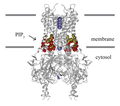Inward-rectifier potassium channel: Difference between revisions
CSV import |
CSV import |
||
| Line 28: | Line 28: | ||
{{Membrane biology}} | {{Membrane biology}} | ||
{{medicine-stub}} | {{medicine-stub}} | ||
<gallery> | |||
File:TREK_PIP2.png|Inward-rectifier potassium channel | |||
File:Inward-rectification.png|Inward-rectifier potassium channel | |||
</gallery> | |||
Latest revision as of 01:04, 18 February 2025
Inward-rectifier potassium channels (IRK channels) are a specific subset of potassium channels that are distinguished by their ability to conduct potassium ions more effectively into the cell rather than out of it. This unique property is vital for maintaining the resting membrane potential of cells and plays a crucial role in various physiological processes, including the regulation of heartbeat, insulin release, and neuronal excitability.
Structure and Function[edit]
Inward-rectifier potassium channels are characterized by their structure, which includes two transmembrane domains and a pore loop that is critical for ion selectivity. These channels are part of the larger family of potassium channels, which also includes voltage-gated, calcium-activated, and two-pore-domain potassium channels. The inward-rectification property of these channels is attributed to the presence of magnesium and polyamines within the cell, which block the channels at depolarized membrane potentials, thus favoring the influx of potassium ions during hyperpolarized states.
Physiological Role[edit]
The physiological importance of IRK channels is underscored by their involvement in several key processes:
- In the heart, they contribute to the stabilization of the resting membrane potential and the repolarization phase of the cardiac action potential, influencing heart rate and rhythm.
- In pancreatic beta cells, they are involved in the regulation of insulin secretion, responding to changes in blood glucose levels.
- In the brain, they play a role in setting the resting membrane potential of neurons, affecting neuronal excitability and the regulation of neurotransmitter release.
Clinical Significance[edit]
Alterations in the function or expression of inward-rectifier potassium channels have been linked to a variety of diseases. For example, mutations in genes encoding these channels can lead to arrhythmias, such as Long QT Syndrome and Atrial Fibrillation. In the pancreas, dysregulation of IRK channels can impact insulin secretion and contribute to the development of diabetes mellitus. Furthermore, in the nervous system, changes in the activity of these channels have been associated with epilepsy and other neurological disorders.
Genetic Diversity[edit]
There are several genes that encode for the various subtypes of inward-rectifier potassium channels, including KCNJ2 (Kir2.1), KCNJ11 (Kir6.2), and others. Each subtype has a distinct tissue distribution and physiological role, contributing to the diversity of functions mediated by these channels.
Pharmacology[edit]
The pharmacological modulation of IRK channels represents a potential therapeutic strategy for treating diseases associated with their dysfunction. For instance, sulfonylureas are a class of drugs that inhibit the Kir6.2-containing channels in pancreatic beta cells, thereby stimulating insulin release and used in the treatment of type 2 diabetes. Conversely, activators of these channels could potentially be used to treat disorders characterized by excessive insulin secretion.
Research Directions[edit]
Ongoing research aims to further elucidate the molecular mechanisms governing the function of inward-rectifier potassium channels, their role in disease, and their potential as therapeutic targets. Advances in this field could lead to the development of novel treatments for cardiovascular, metabolic, and neurological disorders.
| Membrane biology | ||||||||||
|---|---|---|---|---|---|---|---|---|---|---|
This membrane biology-related article is a stub. You can help WikiMD by expanding it.
|
-
Inward-rectifier potassium channel
-
Inward-rectifier potassium channel

